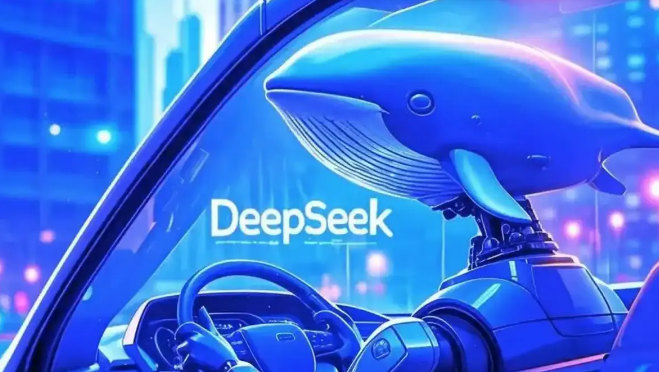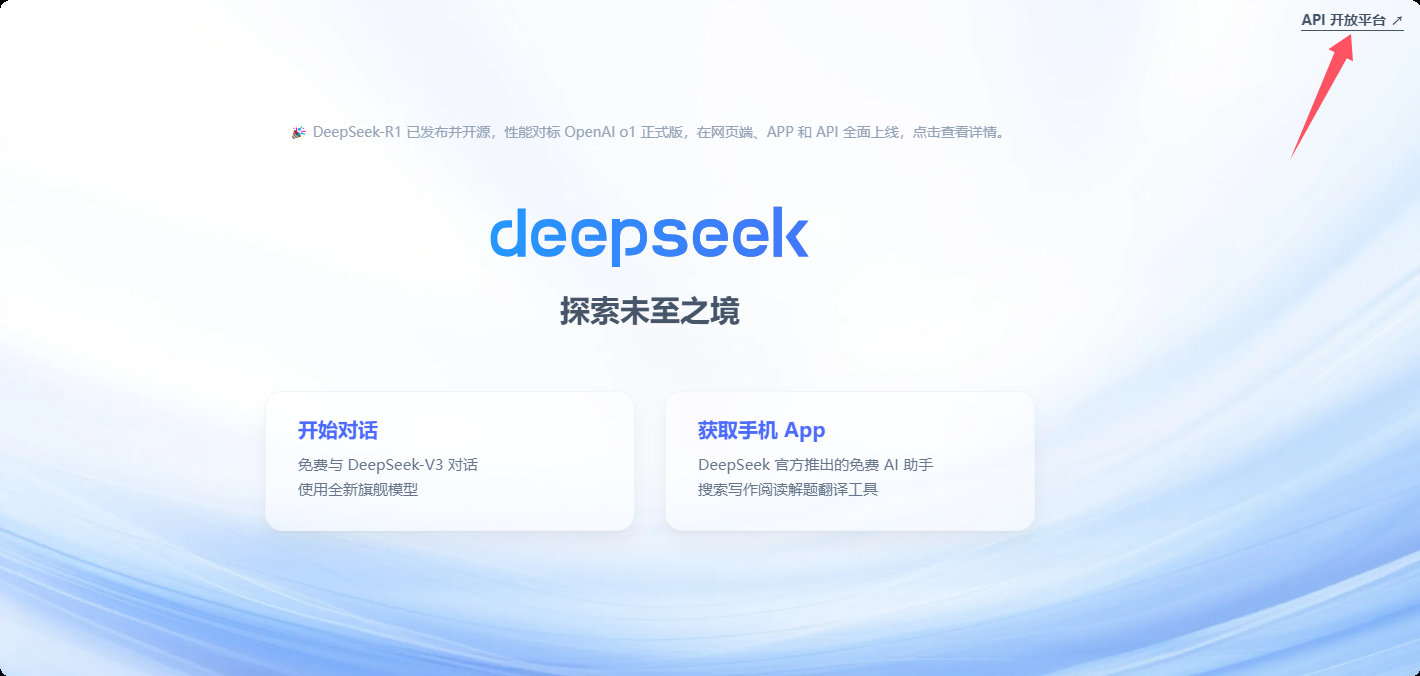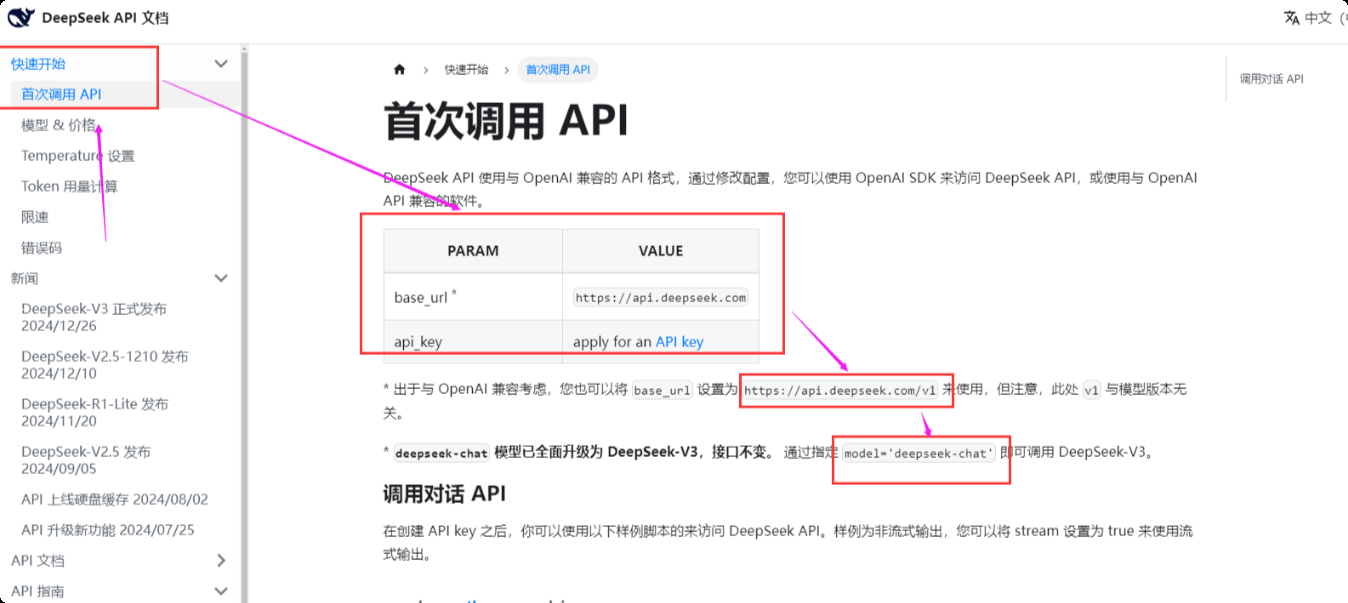 Mobile Game Tutorial
Mobile Game Tutorial
 Mobile Game Guide
Mobile Game Guide
 How to access DeepSeekapi - DeepSeekapi access call tutorial
How to access DeepSeekapi - DeepSeekapi access call tutorial
How to access DeepSeekapi - DeepSeekapi access call tutorial
Detailed explanation of DeepSeek API access and call: Quick guide
This article will provide you with detailed instructions on how to access and call the DeepSeek API, helping you easily use powerful AI models.

Step 1: Obtain the API key
- Visit the DeepSeek official website and click on the "Open Platform" in the upper right corner.

You will get a certain number of free tokens (for metering API usage). In the menu on the left, click "API Keys" and then click "Create API key".
Name your API key (for example, "test") and copy the generated key immediately. Be sure to save this key properly as it will only be displayed once.



Step 2: Get base_url and chat_model
- In the Quick Start section of the DeepSeek API documentation, find
base_urlandchat_modelparameters. The acquisition methods of other platforms are similar.
Step 3: Configure model parameters
For security reasons, it is recommended to store the API key in environment variables rather than writing directly into the code. The following two methods are provided:
Method 1: The terminal temporarily sets environment variables (only valid in the current terminal session)
Enter the following command in the terminal to add your API key to the environment variable (replace YOUR_API_KEY with your actual key):
export API_KEY="YOUR_API_KEY"
Method 2: Create .env file (recommended)
- Create a file named
.env. - Add the following in the
.envfile, replacingYOUR_API_KEYwith your actual key:
<code>API_KEY="YOUR_API_KEY"</code>
In Python code, use the python-dotenv library to read environment variables:
from dotenv import load_dotenv
import os
load_dotenv() # Load the .env file api_key = os.getenv("API_KEY")Step 4: Create a client
Create a DeepSeek client using base_url and api_key . (The specific client creation method depends on the library you are using)
Step 5: Test API calls
Here is a simple Python code example for testing API connections:
# ... (Previous code, including client creation) ...
response = client.chat(model=chat_model, messages=[{"role": "user", "content": "Hello"}])
print(response)If everything is configured correctly, you will receive a reply from the model. If an error occurs, check that your API key and configuration are correct.
For more details, please refer to the official DeepSeek document. Original link (please replace it with the actual link)
The above is the detailed content of How to access DeepSeekapi - DeepSeekapi access call tutorial. For more information, please follow other related articles on the PHP Chinese website!

Hot AI Tools

Undresser.AI Undress
AI-powered app for creating realistic nude photos

AI Clothes Remover
Online AI tool for removing clothes from photos.

Undress AI Tool
Undress images for free

Clothoff.io
AI clothes remover

Video Face Swap
Swap faces in any video effortlessly with our completely free AI face swap tool!

Hot Article

Hot Tools

Notepad++7.3.1
Easy-to-use and free code editor

SublimeText3 Chinese version
Chinese version, very easy to use

Zend Studio 13.0.1
Powerful PHP integrated development environment

Dreamweaver CS6
Visual web development tools

SublimeText3 Mac version
God-level code editing software (SublimeText3)

Hot Topics
 What are the top ten virtual currency trading apps? Recommended on the top ten digital currency exchange platforms
Apr 22, 2025 pm 01:12 PM
What are the top ten virtual currency trading apps? Recommended on the top ten digital currency exchange platforms
Apr 22, 2025 pm 01:12 PM
The top ten secure digital currency exchanges in 2025 are: 1. Binance, 2. OKX, 3. gate.io, 4. Coinbase, 5. Kraken, 6. Huobi, 7. Bitfinex, 8. KuCoin, 9. Bybit, 10. Bitstamp. These platforms adopt multi-level security measures, including separation of hot and cold wallets, multi-signature technology, and a 24/7 monitoring system to ensure the safety of user funds.
 What are the stablecoins? How to trade stablecoins?
Apr 22, 2025 am 10:12 AM
What are the stablecoins? How to trade stablecoins?
Apr 22, 2025 am 10:12 AM
Common stablecoins are: 1. Tether, issued by Tether, pegged to the US dollar, widely used but transparency has been questioned; 2. US dollar, issued by Circle and Coinbase, with high transparency and favored by institutions; 3. DAI, issued by MakerDAO, decentralized, and popular in the DeFi field; 4. Binance Dollar (BUSD), cooperated by Binance and Paxos, and performed excellent in transactions and payments; 5. TrustTo
 How many stablecoin exchanges are there now? How many types of stablecoins are there?
Apr 22, 2025 am 10:09 AM
How many stablecoin exchanges are there now? How many types of stablecoins are there?
Apr 22, 2025 am 10:09 AM
As of 2025, the number of stablecoin exchanges is about 1,000. 1. Stable coins supported by fiat currencies include USDT, USDC, etc. 2. Cryptocurrency-backed stablecoins such as DAI and sUSD. 3. Algorithm stablecoins such as TerraUSD. 4. There are also hybrid stablecoins.
 Python vs. JavaScript: Development Environments and Tools
Apr 26, 2025 am 12:09 AM
Python vs. JavaScript: Development Environments and Tools
Apr 26, 2025 am 12:09 AM
Both Python and JavaScript's choices in development environments are important. 1) Python's development environment includes PyCharm, JupyterNotebook and Anaconda, which are suitable for data science and rapid prototyping. 2) The development environment of JavaScript includes Node.js, VSCode and Webpack, which are suitable for front-end and back-end development. Choosing the right tools according to project needs can improve development efficiency and project success rate.
 The Future of Python and JavaScript: Trends and Predictions
Apr 27, 2025 am 12:21 AM
The Future of Python and JavaScript: Trends and Predictions
Apr 27, 2025 am 12:21 AM
The future trends of Python and JavaScript include: 1. Python will consolidate its position in the fields of scientific computing and AI, 2. JavaScript will promote the development of web technology, 3. Cross-platform development will become a hot topic, and 4. Performance optimization will be the focus. Both will continue to expand application scenarios in their respective fields and make more breakthroughs in performance.
 What are the next thousand-fold coins in 2025?
Apr 24, 2025 pm 01:45 PM
What are the next thousand-fold coins in 2025?
Apr 24, 2025 pm 01:45 PM
As of April 2025, seven cryptocurrency projects are considered to have significant growth potential: 1. Filecoin (FIL) achieves rapid development through distributed storage networks; 2. Aptos (APT) attracts DApp developers with high-performance Layer 1 public chains; 3. Polygon (MATIC) improves Ethereum network performance; 4. Chainlink (LINK) serves as a decentralized oracle network to meet smart contract needs; 5. Avalanche (AVAX) trades quickly and
 Which of the top ten transactions in the currency circle? The latest currency circle app recommendations
Apr 24, 2025 am 11:57 AM
Which of the top ten transactions in the currency circle? The latest currency circle app recommendations
Apr 24, 2025 am 11:57 AM
Choosing a reliable exchange is crucial. The top ten exchanges such as Binance, OKX, and Gate.io have their own characteristics. New apps such as CoinGecko and Crypto.com are also worth paying attention to.
 What is DLC currency? What is the prospect of DLC currency
Apr 24, 2025 pm 12:03 PM
What is DLC currency? What is the prospect of DLC currency
Apr 24, 2025 pm 12:03 PM
DLC coins are blockchain-based cryptocurrencies that aim to provide an efficient and secure trading platform, support smart contracts and cross-chain technologies, and are suitable for the financial and payment fields.





